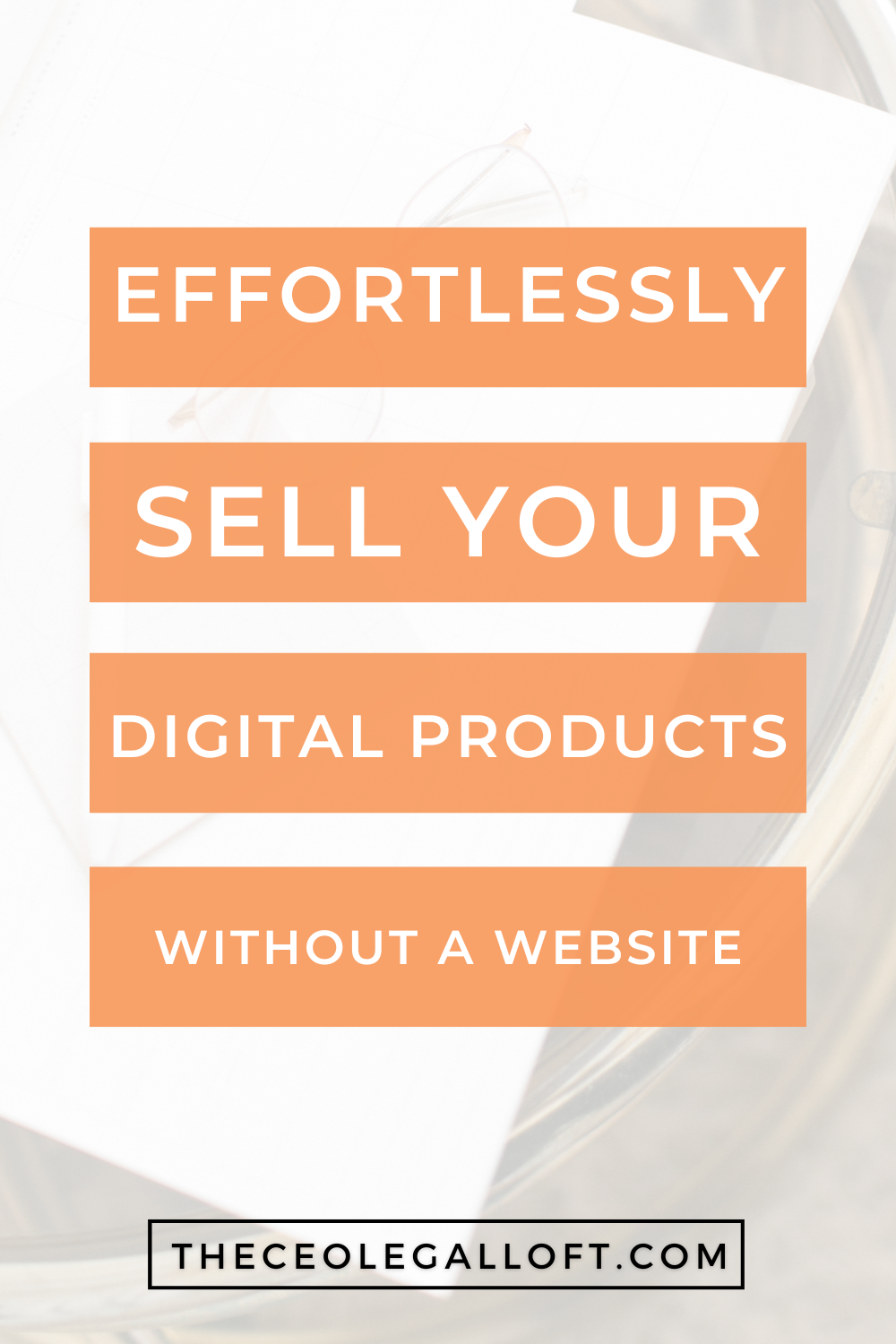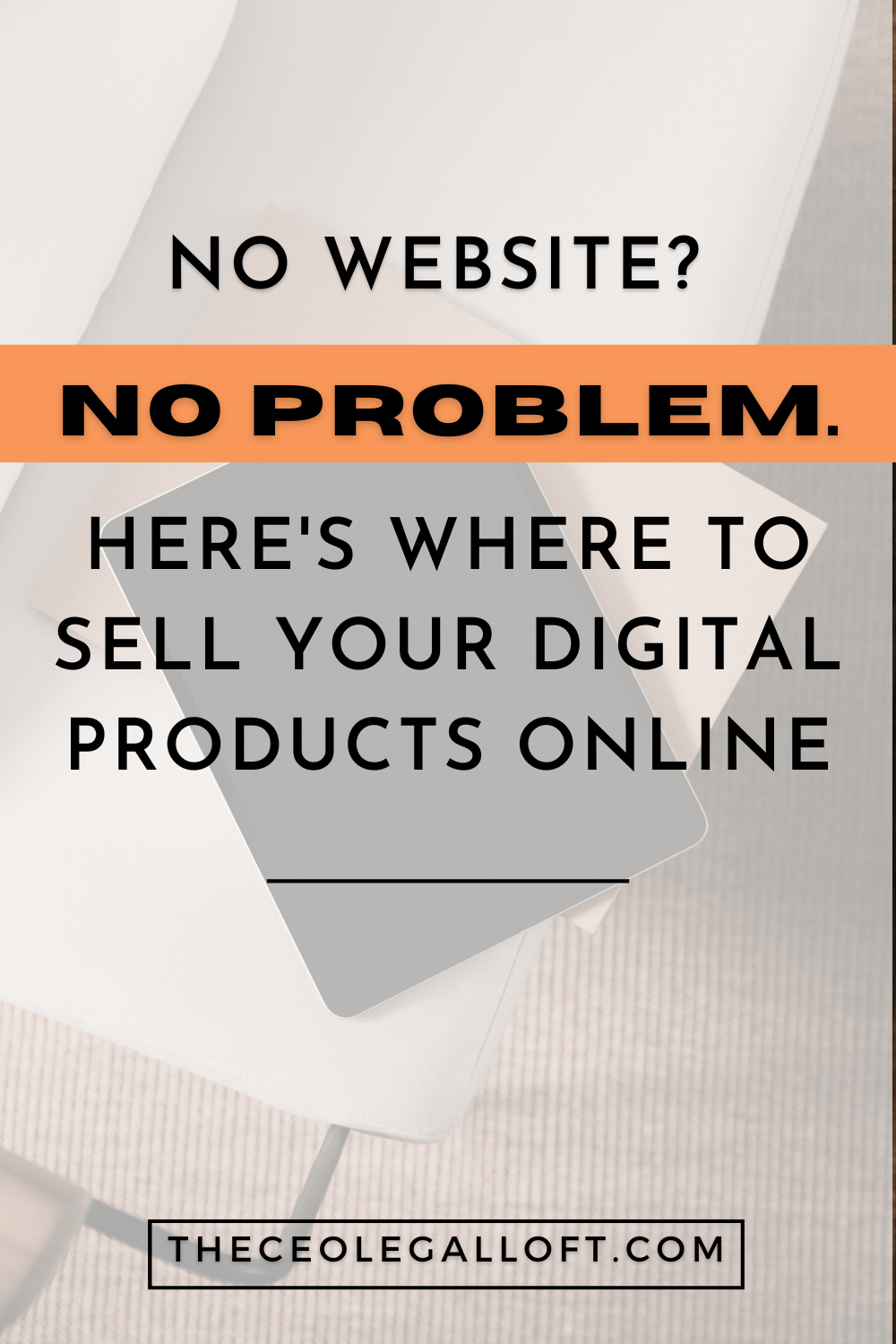Disclaimer: There are some affiliate links in this blog post. That means if you sign up with my link, I’ll receive a commission.
Are you looking for ways to make money online without having a website? If so, you’re not alone. Many entrepreneurs are looking for ways to monetize their digital products without the need of a website. Fortunately, there are plenty of options available to help you sell your digital products even if you don’t have a website. From selling on major marketplaces like Amazon and eBay to leveraging social media networks such as Facebook, TikTok, and Instagram. However, this article will provide you with platforms (some popular and some not as known) so you can sell digital products online successfully.
Whether you’re just starting out or already have an established presence online, these platforms will help you monetize your platforms. Most of these platforms use little tech and the majority are cheap to get started on. So let’s dive in!

What are digital products?
Digital products are products that exist in a digital form and can be accessed or consumed through the internet. Examples of digital products include ebooks, private podcasts or audio courses, online courses, templates, and graphics. Digital products provide consumers with convenience as they can be purchased from anywhere at any time without having to go to a physical store. Additionally, digital products can be quickly updated with new features or content. Ultimately, digital products provide consumers with an easy way to access what they need while also saving time and money.
Where are the best places to sell my digital downloads when I don’t have a website?
GUMROAD
Gumroad was the first place I sold my digital product. It allows you to quickly and easily set up an online store, so that you can start selling your products right away. Gumroad makes it easy to accept payments, manage orders, create discount codes, and track sales. With Gumroad’s user-friendly interface, it’s easy to get your store up and running in no time. Additionally, you can use Gumroad to promote and market your products through email campaigns (you can email through their platform) and social media networks. You can also add an affiliate program to your marketing efforts with Gumroad. If one of your purchasers recommends you, they’ll share their affiliate link and get a commission from the sale.
Gumroad previously had tier based pricing but now charges a 10% fee on each transaction. I’ve used Gumroad for my e-books and courses. I didn’t love it for courses but they’ve made a lot of changes since I last put a course on there in 2019, so it may have better functionality now. And if you do have a website, you can embed your Gumroad checkout to your website.
CONVERTKIT COMMERCE
Convertkit is known for their email marketing but in the last few years they added Convertkit Commerce. This platform enables entrepreneurs to easily sell digital products such as e-books, paid newsletters, and subscription services. You can also add a tip jar if you’re not selling anything but are creating content and want to ask your email subscribers to contribute with any costs for creating the content.
Convertkit Commerce is available on the free plan so you can build your list while selling. You can offer 3 payment types: one-time purchases, recurring subscriptions, or pay what you want. They charge 3.5%+ .30 transaction fee for each sale. If list building is one of your marketing goals, then I highly recommend this platform.
THRIVECART
Thrivecart has been a game changer for my business. It’s an incredible checkout platform for digital product sellers. It allows users to quickly and easily create stunning online checkout pages that are designed to maximize conversion rates and simplify the payment process. With Thrivecart, you can sell digital products from any website or landing page and build your own custom checkout page with their drag-and-drop builder.
I’ve even created sales pages on Thrivecart thanks to my business friend, Dama Jue. She makes BEAUTIFUL sales pages built directly on Thrivecart for different types of products like tripwires, retreats, a private podcast, and more. You can see an example of her work on my LLC Launch sales page.
Some other features Thrivecart offers are fraud protection, tax automation features, full analytics tracking so you can monitor your sales performance in real time. Thrivecart also has an AWESOME affiliate program so that others who enjoy your products can market for you. Thrivecart recently added a course platform Learn to their arsenal of features so it automatically enrolls someone into your course when use the checkout.
Thrivecart costs $495 for the standard plan and $690 for the pro plan. This is a lifetime deal and I’ve made my money back since investing in this tool.
All in all, Thrivecart is an excellent choice for anyone who wants to make selling digital products a breeze.

SENDOWL
Sendowl is very similar to Gumroad. SendOwl is an e-commerce platform that helps businesses sell digital products and services. It offers a range of features to help entrepreneurs manage their online stores, from setting up product listings to automatically generating payment links for customers. SendOwl also provides detailed analytics on sales performance and customer engagement, as well as the ability to set up subscription plans. It integrates with numerous payment gateways and social media platforms, enabling users to easily promote their products and reach new audiences. Additionally, SendOwl provides tools for creating discount codes, tracking orders, and managing tax rates.
SendOwl has a free plan where they take a 5% transaction fee for every purchase up to a $99 premium plan ($0.20 transaction fee). SendOwl also offers storage for your digital products (up to 1000GB depending on the plan you choose). Like Gumroad and Thrivecart, SendOwl offers an affiliate program so others can promote your products through affiliate links.
GOOGLE DOCS WITH PAYPAL OR STRIPE
If creating a sales page is the bane of your existence, like it is mine, I recommend just creating a Google Doc and adding a link to a Paypal checkout or Stripe checkout. If you are looking for an easy way to sell digital products, then using Google Docs with PayPal or Stripe is a great option. All you need to do is create your product in Google Docs, then connect it to PayPal or Stripe and you will be able to start selling within minutes. This can save you time and money as there are no setup fees or third-party services required. Additionally, both payment processors are secure and reliable, so your customers’ data and payments will be safe. You can also customize the checkout page for your brand, giving customers a personalized experience when they purchase from you. With Google Docs and either of these payment solutions, you can easily start selling digital products online.
With this method, you’ll have to use Zapier to automatically send out your digital product or send the digital product manually through email.
FLODESK
Flodesk Checkout is a new feature for Flodesk. Like Convertkit, Flodesk is an email marketing platform first. One of the biggest advantages is its user-friendly interface, which makes it easy for customers to purchase products and for merchants to manage sales. Additionally, it offers a seamless integration with other tools like email marketing and payment gateways, which can help streamline the sales process.
Flodesk also allows you to create a sales page so you can customize your checkout and delivery page to your branding. They also give you templates so you don’t have to start from scratch.
Another advantage is that it allows for the use of one-click upsells, which can help increase sales and customer engagement. They offer detailed analytics and reporting features that can help merchants track sales and customer behavior.
Flodesk Checkout charges $35/month and a 3% + $0.30 Stripe processing fee on transactions.

STAN.STORE
The Stan Store is a newer platform that rose to popularity due to TikTok. Many of those creators started promoting it and it has grown exponentially. Think of the Stan Store as a baby between Gumroad and Linktree. On Stan, you can not only sell digital products like ebooks and courses, but there’s a calendar function. If you take discovery calls or have 1:1 coaching where someone needs to make an appointment, this is an awesome tool. You can also offer a Personalized Video Response so people can ask you questions and you don’t have to worry about someone picking your brain for free. Just direct them to this offer.
Stan will cost you a monthly subscription of $29 or 79 per month. There are no associated transaction fees.
ETSY
I was hesitant on including Etsy on this list as many creators have been moving away from the platform. But it’s still a super popular place to sell digital product.
On the plus side, it is a well-known platform that attracts buyers from all over the world. It also gives sellers access to a large pool of potential customers and tools to help them manage their stores and products more efficiently.
On the other hand, selling on Etsy can be competitive as there are many similar products available. Additionally, sellers must pay fees for listing items, processing payments, and advertising their stores. Finally, due to its popularity, Etsy can become overcrowded during peak seasons making it difficult for new sellers to stand out from the competition. All in all, selling on Etsy can be a great opportunity but one should consider both the advantages and disadvantages before starting a store on there.
How to fight piracy while selling your digital content online?
Fighting piracy of your digital content can be a daunting task. The best way to combat it is to use a combination of strategies.
First, you should invest in tools that allow you to track where your content is being used and who is downloading it illegally. You can add PDF stamping through SendOwl and Gumroad to help identify someone who’s selling your product illegally. A digital watermark, also known as a PDF stamp, can be used to protect digital documents from being copied or edited without permission. It is an effective way to prove authorship of a document and discourage unauthorized copying. The watermark can contain identifying information such as the author’s name, copyright notice, URL address, or any other text or image that will deter people from using the content without authorization. You can then take legal action against those responsible for the copyright infringement.
Secondly, consider implementing copy protection technologies to make it harder for people to copy or steal your work. Thirdly, educate people about the importance of respecting copyrights and how they can help protect their own work by doing the same. Finally, ensure that any contracts you enter into with third parties contain clear clauses on respect for intellectual property rights and take steps to enforce those rights if necessary.
By taking these steps, you can help protect your digital products from piracy and ensure that you get the recognition and compensation you deserve for your hard work.
Conclusion: Where to sell digital content online when you don’t have a website
It is important to remember that there are different ecommerce platforms available to fit individual needs. It is vital to research and choose the right platform for your product, budget, and lifestyle. Each has their own advantages and disadvantages so it is important to look at all the options before making a decision.
Want to learn how to market your digital products online so they can sell without you being in front of a computer or on social media 24/7? Check out Ready, Set, Market Your Digital Product. This is a training where I teach you the methods I use for selling my digital products.


+ show Comments
- Hide Comments
add a comment